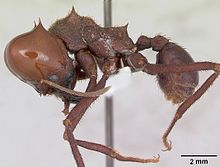This article needs additional citations for verification. (March 2011) |
| Atta laevigata | |
|---|---|

| |
| A. laevigata worker | |
| Scientific classification | |
| Domain: | Eukaryota |
| Kingdom: | Animalia |
| Phylum: | Arthropoda |
| Class: | Insecta |
| Order: | Hymenoptera |
| Family: | Formicidae |
| Subfamily: | Myrmicinae |
| Genus: | Atta |
| Species: | A. laevigata
|
| Binomial name | |
| Atta laevigata | |
Atta laevigata (Smith, 1858) is one of about a dozen species of leafcutter ants in the genus Atta, found from Venezuela and south to Paraguay. This species is one of the largest leafcutter species, and can be recognized by the smooth and shining head of the largest workers in a colony. Atta laevigata is known in northern South America as hormiga culona (literally translated as "big-assed ant"), or as sikisapa in Peru, zompopo de mayo in Central America, bachaco culón in Venezuela, akango in Paraguay, and chicatana in Mexico.[2][3] In Brazil they are known as "saúva-cabeça-de-vidro" (literally "glass-headed saúva"), with saúva being the common name for all Atta ants.[4]
The colony sizes of these ants are made up of around 3.5 million individuals.[5]
- ^ "Atta laevigata". AntWeb. California Academy of Sciences. Retrieved 2016-07-11.
- ^ Philip Sloan; Willy Legrand; Clare Hindley, eds. (2015). The Routledge Handbook of Sustainable Food and Gastronomy. Routledge. p. 303. ISBN 9781134457403.
- ^ "Chicatanas". www.exploringoaxaca.com (in Spanish). Archived from the original on 5 February 2017. Retrieved 5 February 2017.
- ^ "Saúva-cabeça-de-vidro: habitat e características". Meus Animais (in Portuguese). 2021-05-29. Retrieved 2023-04-30.
- ^ Hölldobler, Bert; Wilson, Edward O. (2009). The Superorganism: The Beauty, Elegance, and Strangeness of Insect Societies. W. W. Norton & Company. ISBN 9780393067040.